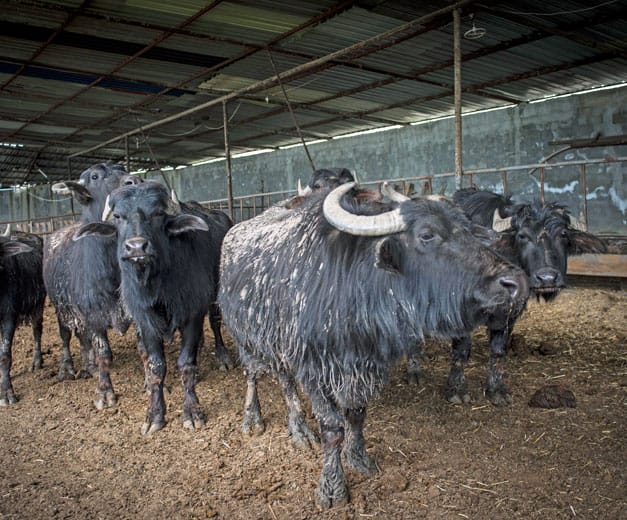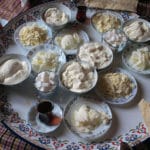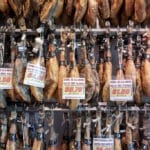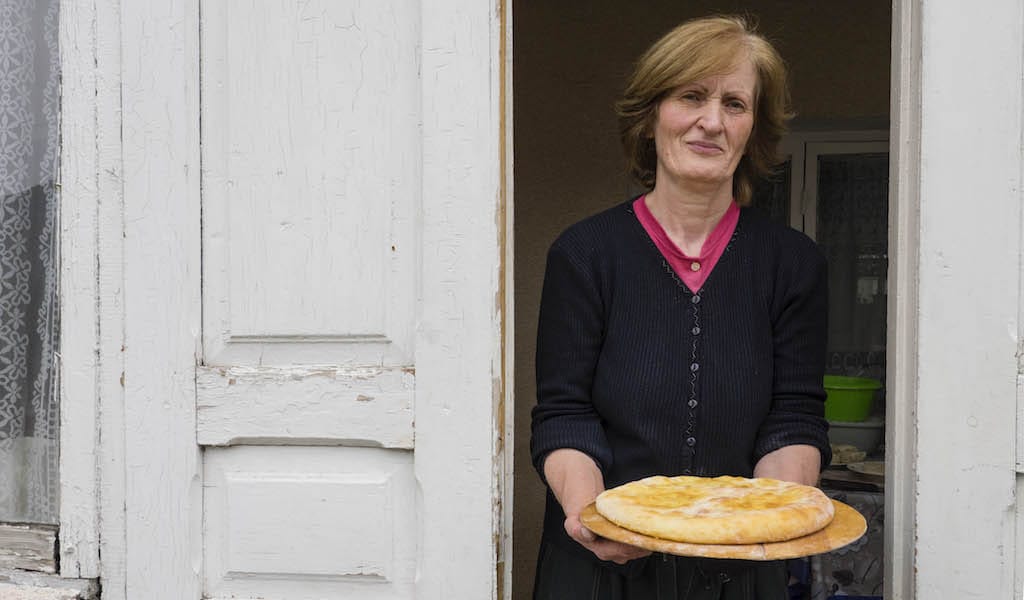Charming and surprising, Fehmi Özsüt has an easy, no-worries smile that belies a life full of unbelievable stories and intense work. Every day, even on weekends, he wakes up at 3 a.m. in order to run his kaymak business. A quivery clotted cream made from water buffalo milk, kaymak is served with honey and bread for a rich and filling breakfast. Since 1915, Özsüt’s family of Albanian immigrants has run the Karaköy Özsüt muhallebici, or milk pudding shop. Now he is carrying the torch and managing a small water buffalo farm to supply the main ingredient for the shop’s traditional desserts.
Back when Özsüt’s grandfather started his kaymak business, water buffaloes were raised in the forests around Istanbul. The animals flourished in the shade of those trees, and shepherds didn’t need to buy feed for the animals. Each muhallebici would buy fresh milk from nearby producers to make its yogurt, kaymak and desserts. Now, the few small forests left around Istanbul are for recreation.
In 2002, Özsüt started his own water buffalo farm in Sarıyer, 45 minutes north of Istanbul, because he could no longer buy high-quality milk at a reasonable price. In 2005 he had to move further afield, to Kemerburgaz near the Black Sea, because his buffaloes were destroying the palm trees in the new luxury compounds popping up near his farm. In 2011, he moved to his current location near Tekirdağ, which has rich soil and an abundant water supply but is an hour-and-a-half-long drive west of Istanbul.
Özsüt doesn’t mind the drive because he feels it is worth it to make his customers happy and to continue providing fresh buffalo milk kaymak for breakfast. Although kaymak and milk puddings are less popular among Istanbul’s younger generations, Özsüt continues to uphold the quality of his grandfather’s and father’s desserts for loyal customers and food-curious travelers. He used to make kaymak ice cream in summer, which older customers would order two scoops of to top tavuk göğüsü (chicken breast pudding). They said it tasted just as it did when they were kids. “It is the same taste. The same animal. They don’t forget the taste,” Özsüt says.
Before running the family business, Özsüt lived for five years in Phoenix, Arizona, where he worked as a security guard at the Waldorf Astoria hotel. “It was a fun job,” he remembers. “I met Ronald Reagan and George Bush, Sr., but it was too hot, and as an employee you weren’t allowed to swim in the swimming pool.” He regales us with stories of wrestling belligerent rock superstars to the ground, hanging out with bounty-hunter coworkers and taking English night classes. Now his days are filled with finicky buffaloes.
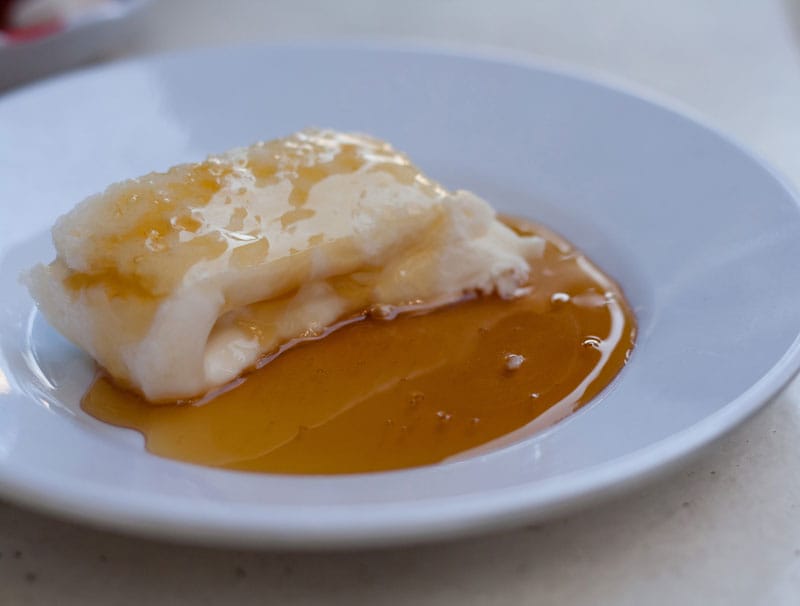
We recently visited his farm, which is a five-minute drive from the Marmara Sea coast through rolling, green rapeseed-covered hills. We passed the communal field where villagers leave their cows and donkeys to graze, then proceeded through the quiet, sun-drenched streets. A few giant Kangal dogs and their pups welcomed us as we pulled the milk truck into the dirt driveway. A new two-story house for the live-in shepherd couple sat a stone’s throw from the milking house, where a dozen buffaloes quietly snacked on wild greens. The farm buildings were modest and, seeing as how Özsüt moves his operation every few years, it made sense that the infrastructure was not fancy.
Water buffaloes are wild animals, not at all like the robotic, domesticated dairy cows in the U.S. They are spunky, unpredictable and smart. If you leave domestic dairy cows in an open field, they will be in the same place at night. Buffaloes will run 30 miles away – hence the broken palm trees in Sarıyer. They like the shade, and they roll in the mud to cool their black coats down. They are surprisingly agile for their size, and some licked our hands curiously with their long, thin, giraffe-like tongues. Özsüt’s favorite and oldest buffalo is named Yatık Boynası (“Slanted Horn”). We visited the less intimidating five-week-old calves, whose buckteeth, bulging eyes and awkward hair tufts gave them a remarkably expressive and hilarious appearance. In a few years the females would be fertilized and would start producing milk, and the males would be sold for their meat. It costs Özsüt around 7,000 TL to buy a buffalo, and they live to be 33 years old, producing milk most of their lives. Although “the buffalo business is getting very small,” he is still able to find buffalo breeders in southeast Turkey’s Diyarbakır and near Sarıyer.
Because the buffaloes are wild, the shepherds have to be extremely skilled and brave to successfully manage a herd and get milk from the animals. Female buffaloes will only give milk if they know the shepherd, Özsüt said, and even then the shepherds endure kicks and sometimes worse. Calves are separated from their mothers at birth so that the mothers can be milked, just like in conventional dairying. However, water buffaloes require their calves to be brought to them every time to start suckling before the shepherd steps in to get the rest of the milk. If the wrong calf is brought to the mother, she will not give milk that day. If the calf dies for some reason, the shepherds wrap the calf’s hide around a form and put it near the mom to try and trick her into giving milk. Even then, there’s a possibility that she won’t be fooled.
All of this effort is for the gorgeous milk. Water buffaloes produce six kilos of luxuriously thick milk per day over two milkings, one at 4:30 a.m. and one at 4:30 p.m. They are so sensitive that we weren’t allowed to take pictures during milking because it would upset the animals so much that they wouldn’t give milk. We took a hushed walk with the woman shepherd while the animals were munching their pre-milking snack, and they eyed us suspiciously, even as the shepherd tried to reassure them with her outstretched hand and gentle coos.
While we waited for the woman to finish milking – she does it all because her husband fears the animals’ kicks – Özsüt explained that he usually does repairs around the farm during this time. He is always planning for the future, and ponders building a small restaurant here so city people can come have breakfast on the weekends. “It would be easier to make kaymak and yogurt here and sell it here instead of trucking it all the way to Istanbul.”
Özsüt means “pure milk” in Turkish. It is Fehmi’s family name and is associated with milk pudding makers from Ottoman times. In the 1990s a franchise of milk pudding cafés called Özsüt came on the scene, and Özsüt’s family took the company to court. However, in this type of case, Özsüt explained, Turkish law favors the company with more stores. The court ruled that the chain could continue operating as long as they did not sell their products to other companies. They’ve disobeyed this ruling and now sell milk products in supermarkets.
Özsüt told us he always turns down franchise offers because it is too difficult to maintain the high quality he seeks. This is the nature of the muhallebici business: As products sit in the refrigerator, they lose freshness and can quickly spoil. He explained that muhallebici franchises field more food poisoning complaints because they transport a highly perishable product hundreds of miles with unreliable refrigeration due to power outages. In order to deal with this, some franchises use powdered milk mixed with other synthetic flavorings and colors at their shops. “Plastic-y,” Özsüt said, cringeing.
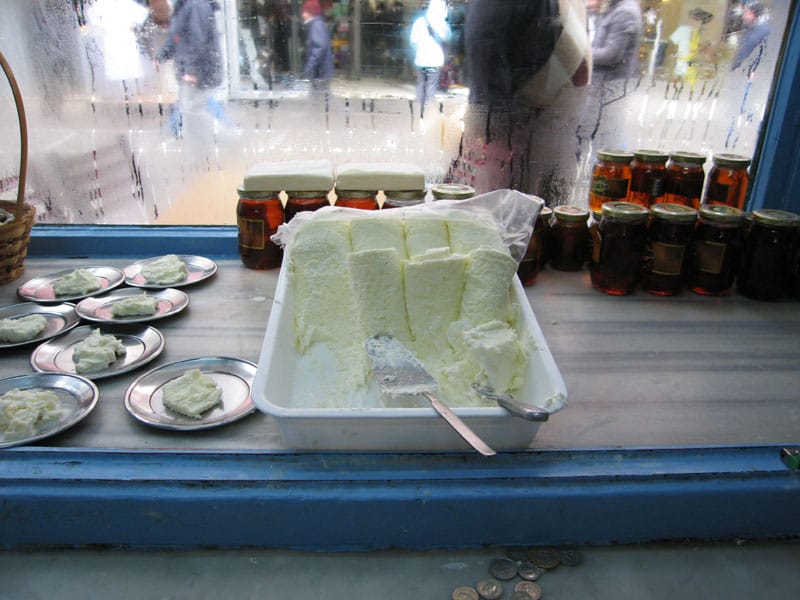
“You can only make kaymak from buffalo milk,” he told us. True kaymak is heated to 85 degrees C, which allows some bacteria to survive, and it gives kaymak its slightly cheesy flavor. According to Özsüt, it’s not even worth eating the kaymak if you overheat it and kill all the bacteria. The heating process takes six to seven hours and involves simmering the fresh buffalo milk in a wide shallow pan in two sessions, cooling it overnight, cutting it and covering it with ice to maintain its texture. When done correctly, the kaymak is thick yet shakes at a whisper. Although he learned a few tips from his father’s workers in the 1990s, Özsüt is a self-taught kaymak maker.
Özsüt is the last of a few muhallebicis who still run their own dairies and supply fresh buffalo milk to their shops. He is not sure who will continue his family’s business after he retires from his demanding schedule. It has to be someone with a passion for the craft and dedication to quality. As Özsüt told us, he does not do this work to make money. “If I didn’t do this, I would just be spoiled. It is like an escape for me.”
Among Özsüt’s numerous and colorful stories is this, perhaps the most improbable, yet also the most poignant: One day he strapped two large plastic jugs full of milk in front of each knee on his motorcycle to deliver throughout Istanbul. A van ran a red light and Özsüt smashed into the side of it in the middle of an intersection. The milk jugs absorbed the shock and he walked away unscathed. Buffalo milk not only provides Özsüt’s livelihood, but actually saved his life.
Published on June 19, 2014
Related stories
October 27, 2017
Tbilisi | By Culinary Backstreets
TbilisiThe author of 14 books, Carla Capalbo is best known for her food- and wine-centric travelogues exploring the lesser-known regions and culinary traditions of Italy. Her last book, Collio: Fine Wines and Foods from Italy’s Northeast, took readers on a gustatory journey through a tiny region that few outside Italy – or even inside Italy,…
December 13, 2013
IstanbulLike many other Central Anatolian cities, Erzincan is one of those places with very little there there. The natural setting – on a high plateau and ringed by craggy peaks – is promising, but the town itself feels like it’s been scrubbed clean of all traces of history or local distinctiveness, its streets lined with…
June 14, 2023
BarcelonaHam is one of Spain’s best-known culinary treasures, and different types of the cured meat offer their own flavors and characteristics depending on the breed of pig, how the animal has been fed and raised and how its meat has been processed and cured. The wide selection of ham in Barcelona can be a bit…







































